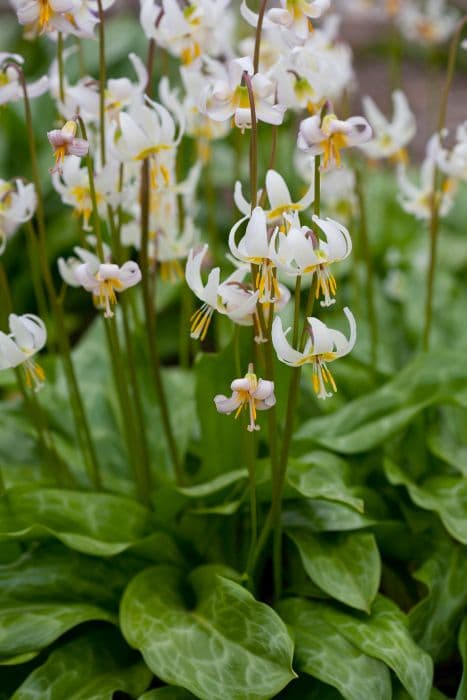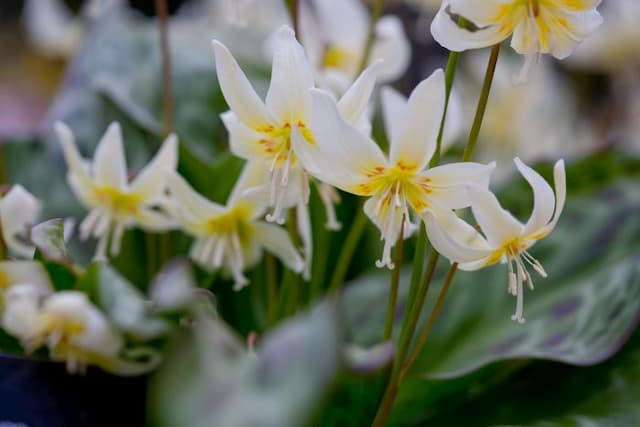California Fawn Lily Erythronium californicum

ABOUT
Erythronium californicum, commonly known as the California fawn lily, is a perennial plant noted for its distinctive beauty. The plant typically produces two broad, mottled leaves that lie close to the ground, resembling the pattern of a fawn's back—hence the name. These leaves have a smooth texture and emerge in early spring. As the season progresses, a single flower stalk rises from the base between the leaves, bearing an elegant, nodding flower atop. The flower's petals and sepals are long and recurved, often creating a delicate, swept-back look. In color, they range from a creamy white to a soft pale pink, with a shade somewhere between yellow and deep orange adorning the base of each petal and sepal, near the flower's center. Its stamens, which protrude from the flower's center, consist of anthers that are typically crowned with yellow pollen, giving a beautiful contrast against the subtle tones of the petals. Below the ground, the plant is sustained by a bulb from which the leaves and the flower stalk emanate annually. Despite its graceful appearance, details concerning the California fawn lily's specific dimensions are withheld.
About this plant
 Names
NamesFamily
Liliaceae
Synonyms
California Fawn Lily, White Beauty
Common names
Erythronium californicum.
 Toxicity
ToxicityTo humans
Erythronium californicum, more commonly known as California fawn lily, does not have a widespread reputation for being poisonous to humans. Generally, members of the Erythronium genus are not considered highly toxic. However, as with any plant, individual sensitivity can vary, and it's possible for someone to have a mild reaction if they have specific allergies or sensitivities. In the absence of recognized toxicity, there are no well-documented symptoms of poisoning from ingesting the California fawn lily. Nonetheless, it is always advisable to avoid consuming plants that are not explicitly stated as edible, as they might cause gastrointestinal discomfort or allergic reactions in sensitive individuals.
To pets
California fawn lily is not typically known for being toxic to pets. However, similar to the precautions for humans, it is advisable to prevent pets from ingesting this plant since the full extent of its possible effects is not well documented. If a pet does ingest part of a California fawn lily, monitor them for signs of gastrointestinal distress or unusual behavior, and consult with a veterinarian if any concerns arise. It's always best to keep an eye on pets around plants, as individual animals may have unique sensitivities or reactions.
 Characteristics
CharacteristicsLife cycle
Perennials
Foliage type
Deciduous
Color of leaves
Green
Flower color
White
Height
1 foot [30 cm]
Spread
1 foot [30 cm]
Plant type
Bulb
Hardiness zones
7
Native area
California
Benefits
 General Benefits
General Benefits- Ecosystem Support: The California fawn lily provides early spring pollen and nectar for a variety of pollinators, including bees.
- Aesthetic Appeal: With its distinctive nodding flowers and mottled leaves, it adds beauty and diversity to woodland gardens.
- Native Habitat Enhancement: As a native species, it contributes to the integrity and function of local ecosystems where it naturally occurs.
- Wildlife Habitat: Its bulbs and foliage can serve as a food source for woodland animals, though it is not a primary food source for many species.
- Conservation: Planting and maintaining populations of California fawn lily can help in the conservation efforts of native plant species.
- Educational Value: It can be used to educate others about native plant species and the need for biodiversity in local environments.
 Medical Properties
Medical PropertiesThis plant is not used for medical purposes.
 Air-purifying Qualities
Air-purifying QualitiesThis plant is not specifically known for air purifying qualities.
 Other Uses
Other Uses- Erythronium californicum, commonly known as 'California fawn lily', bulbs can be ground into a fine powder and used as a flour substitute or thickening agent in cooking, providing a starchy base for recipes.
- Petals of the California fawn lily are sometimes crystallized with sugar and used as edible decorations for desserts, adding a delicate floral touch to sweet dishes.
- The plant's leaves can be incorporated into a natural green dye for textiles, offering a sustainable coloring option for fabrics.
- Pressed California fawn lily flowers can be used in botanical art and herbarium collections, contributing to the documentation and appreciation of native plant species.
- The plant's distinctive mottled leaves are sometimes used in garden design, providing a unique textural and visual element in shade gardens.
- California fawn lily's dried seed pods may be used in dried floral arrangements, adding an unconventional shape and interest to the composition.
- The flower's nectar can occasionally serve as a supplementary food source for domesticated bees in cultivated gardens.
- Embedded in clear resin, the small flowers of the California fawn lily can be used to create unique botanical jewelry pieces, such as pendants and earrings.
- As a subject for photography, the California fawn lily offers a compelling subject for photographers, especially during its blooming period, contributing to plant awareness through visual arts.
- Naturalists can use the presence of California fawn lily populations as an indicator of a healthy ecosystem, as they thrive in undisturbed woodland environments.
Interesting Facts
 Feng Shui
Feng ShuiThe California fawn lily is not used in Feng Shui practice.
 Zodiac Sign Compitability
Zodiac Sign CompitabilityThe California fawn lily is not used in astrology practice.
 Plant Symbolism
Plant Symbolism- Durability: Erythronium californicum, commonly known as the California fawn lily, often symbolizes durability because it is a perennial plant that returns year after year, suggesting resilience and endurance.
- Purity: The delicate and pure white blooms of the California fawn lily represent innocence and cleanliness, often associated with the purity of heart or intention.
- Rebirth: As a spring-blooming flower, it signifies new beginnings and the cycle of rebirth, echoing the renewal of nature after winter.
 Water
WaterCalifornia Fawn Lily should be watered moderately during its growth season in spring. Generally, providing water once a week with about 1 inch (or approximately 0.623 gallons for an average-sized garden area) is sufficient to keep the soil consistently moist but not waterlogged. In the dormant season during summer, reduce watering significantly as the plant prefers drier conditions. It is important to avoid standing water to prevent root rot.
 Light
LightCalifornia Fawn Lily thrives in dappled sunlight, mimicking its natural woodland habitat. It's best situated in a location where it can receive morning sunlight and afternoon shade, or steady, filtered light throughout the day. Avoid direct, harsh sunlight, especially during the peak hours of the afternoon, as it can damage the foliage.
 Temperature
TemperatureCalifornia Fawn Lily does well in a range of temperatures but prefers a cooler climate. The ideal temperature range for this plant is between 50 and 70 degrees Fahrenheit. It can survive minimum temperatures down to around 20 degrees Fahrenheit, but for optimal growth, keeping it within the ideal range is recommended. Sudden temperature fluctuations should be avoided to prevent stress on the plant.
 Pruning
PruningCalifornia Fawn Lily does not typically require pruning except for the removal of faded or dead foliage after flowering. This tidy-up helps prevent disease and may encourage more blooms in the following season. The best time for this minimal pruning is late summer or early fall, once the leaves have yellowed and died back naturally.
 Cleaning
CleaningAs needed
 Soil
SoilCalifornia Fawn Lily requires moist, well-drained soil rich in organic matter with a pH of 6.0 to 7.0. A mix of two-thirds leaf mold or well-rotted compost and one-third coarse sand or perlite would be ideal for ensuring good drainage and fertility.
 Repotting
RepottingCalifornia Fawn Lily bulbs should be repotted every 2-3 years or when the container becomes crowded. It's best to repot after the leaves die back in summer.
 Humidity & Misting
Humidity & MistingCalifornia Fawn Lily thrives in moderate to high humidity levels, similar to its natural woodland habitat. Try to maintain humidity around 50-70% for ideal growth conditions.
 Suitable locations
Suitable locationsIndoor
Provide bright, indirect light and maintain high humidity for California Fawn Lily.
Outdoor
Plant in dappled shade with moist, rich soil for California Fawn Lily.
Hardiness zone
7-9 USDA
 Life cycle
Life cycleErythronium californicum, commonly known as the California Fawn Lily, begins its life cycle when seeds germinate in autumn, after being dispersed in late spring. The seedlings develop small bulbs underground, which go dormant during the summer dry season. In the following spring, the bulbs send up a pair of mottled leaves, and later, a single flower stalk emerges, bearing a white to pale cream flower with a yellow center that can attract pollinators such as bees. After pollination, the ovary develops into a capsule with seeds that are subsequently dispersed by wind or animals. Each year, the plant continues to grow, and established bulbs may produce offsets, leading to the formation of small colonies. After flowering and seed set, the above-ground parts of the plant die back, and the bulbs remain dormant until the next moist season prompts the next cycle of growth.
 Propogation
PropogationPropogation time
Spring
Erythronium californicum, more commonly known as the California Fawn Lily, is most effectively propagated through division, which should ideally be performed in the fall after the leaves have died back. This method involves gently digging up the dormant bulbs, carefully separating them, and replanting the offsets. You can identify the offsets as smaller bulbs growing at the base of a mature bulb. When replanting, ensure the bulbs are placed about 3 inches (approximately 7.6 centimeters) deep and spaced approximately 4 to 6 inches (about 10 to 15 centimeters) apart to allow for future growth. The soil should be rich, well-draining, and preferably slightly acidic. Newly planted offsets should be kept moist but not waterlogged to encourage root development before the winter dormancy period.









